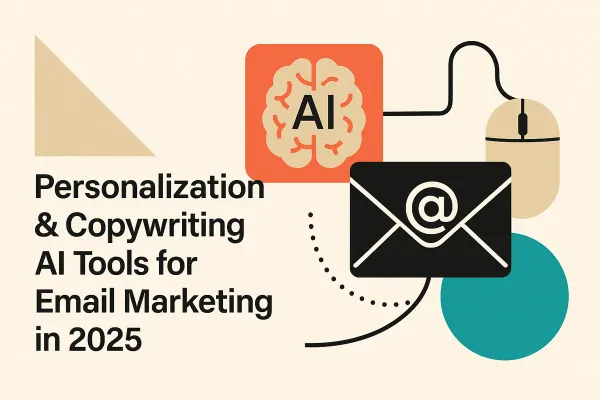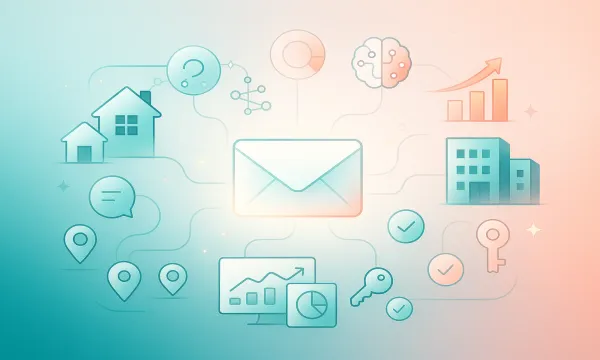Email Marketing for Education: Engaging Students and Alumni
Master email marketing for education in 2025. Proven strategies to engage students and alumni with segmentation and automation.
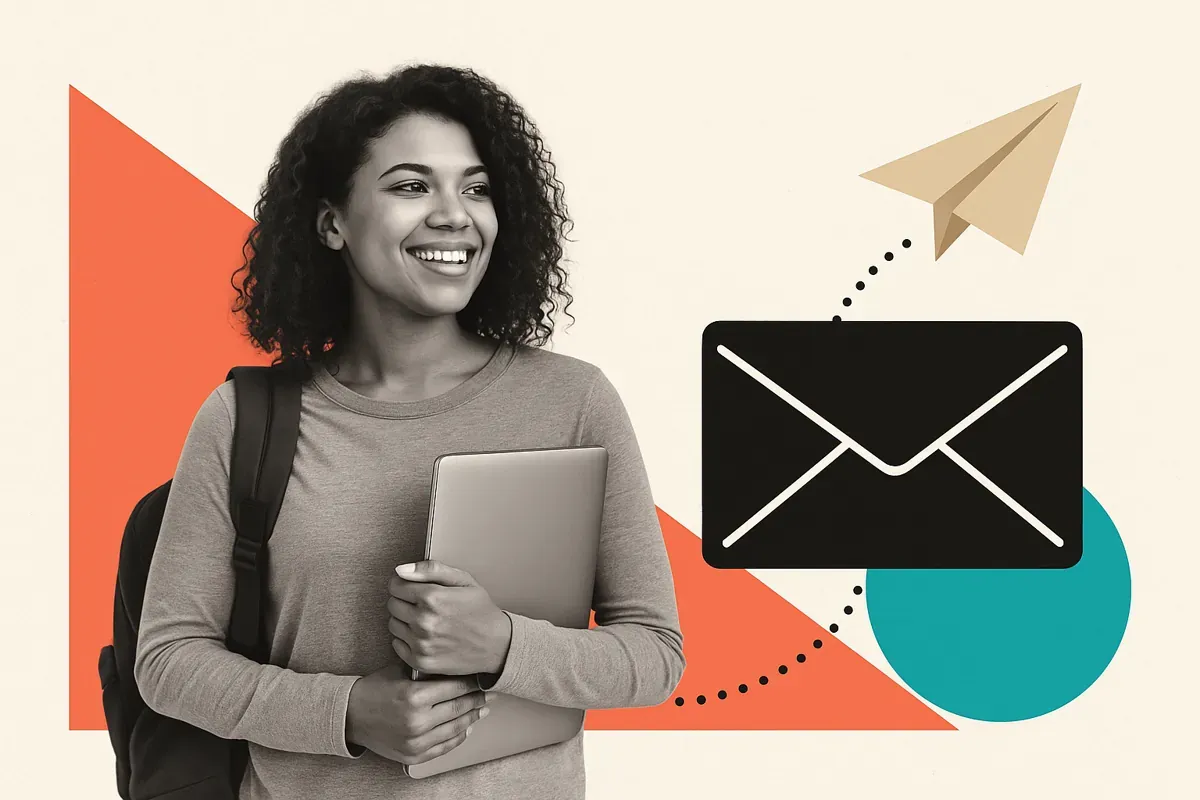
Educational institutions face a unique challenge: maintaining meaningful connections with diverse audiences across different life stages. Current students need timely information about campus events, deadlines, and resources. Alumni want to stay connected to their alma mater, hear about networking opportunities, and understand how their contributions make an impact. Traditional mass-email approaches fail both groups, resulting in declining open rates and disengaged communities.
The solution lies in strategic email marketing that treats each audience segment as distinct, with tailored content that speaks to their specific needs and interests. According to Higher Education Marketing Report 2024, institutions using segmented email campaigns see 58% higher engagement rates compared to one-size-fits-all approaches.
As email marketing practitioners running Groupmail, we've researched email marketing for education extensively—analyzing industry reports, case studies, and expert insights to identify what actually works for colleges, universities, and educational organizations.
TL;DR - Key Takeaways:
- Segment your email lists by student status, program, graduation year, and engagement level for higher relevance
- Plan and schedule timely communications around enrollment, events, and donation campaigns for consistent engagement
- Personalize content beyond first names—reference specific programs, campus locations, and individual milestones
- Optimize send times based on audience data (students respond differently than alumni)
- Build a consistent cadence that maintains visibility without overwhelming inboxes
Why Email Marketing Matters for Educational Institutions
Quick Answer: Email marketing for education provides direct, cost-effective communication with students and alumni, achieving average open rates of 25-30% for higher education—significantly higher than social media reach. It enables personalized engagement at scale, supports enrollment goals, and drives alumni giving programs essential for institutional funding.
Social media algorithms limit organic reach to 2-5% of followers, making it unreliable for critical communications. Email ensures your message reaches the intended audience. Campaign Monitor's Education Benchmarks show that educational institutions achieve 25.8% average open rates and 3.1% click-through rates—both above general nonprofit averages.
Email also supports measurable outcomes tied to institutional goals. Need to increase event attendance? Track registration clicks. Want to boost alumni donations? Monitor giving campaign conversions. According to DMA's Email Marketing ROI Report, email marketing delivers an average ROI of $42 for every $1 spent, making it one of the most cost-effective channels for educational institutions. Unlike awareness campaigns on social platforms, email marketing for education delivers actionable data that informs strategy refinements.
📊 "Educational institutions using segmented email strategies report 58% higher engagement rates than those sending mass communications." — Hanover Research
Additionally, email provides a owned communication channel independent of platform policy changes or algorithm updates. When Instagram or Facebook changes their rules, your email list remains unaffected. This ownership proves invaluable during crises, when rapid communication becomes essential.
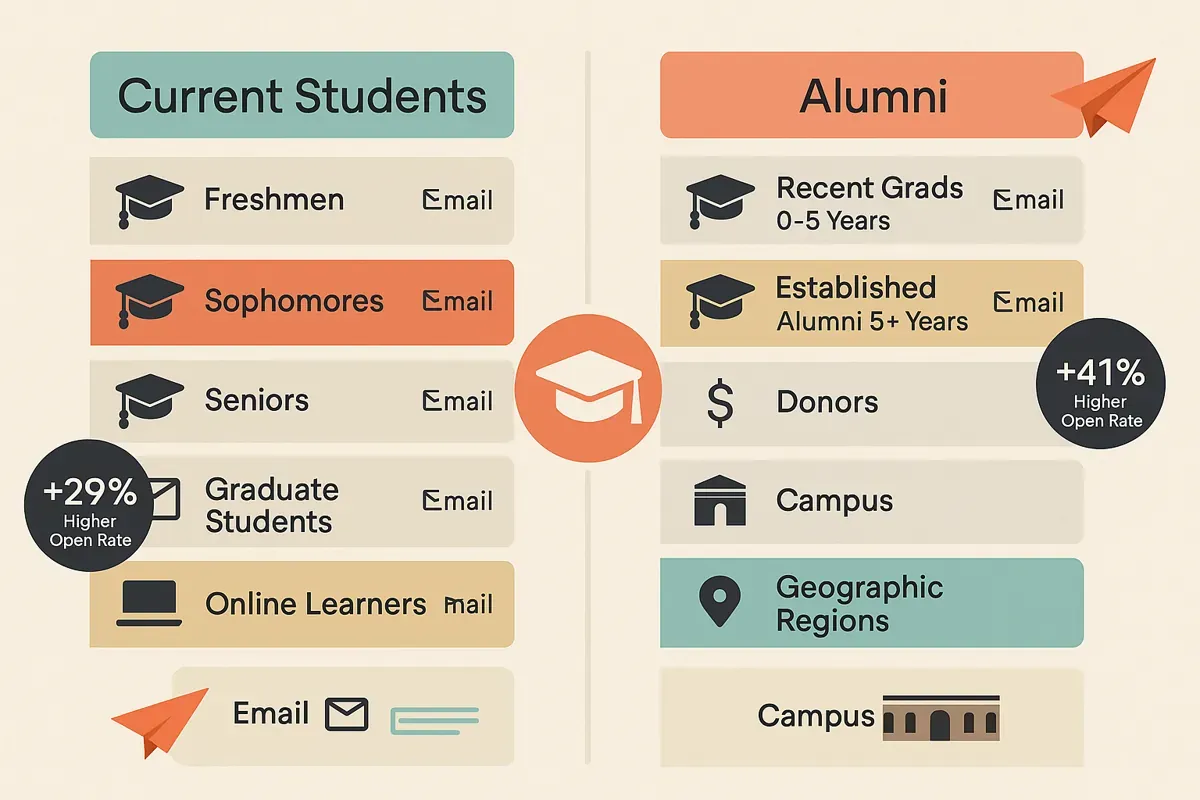
Understanding Your Email Audiences: Students vs. Alumni
Quick Answer: Students need immediate, action-oriented information about academics, campus services, and deadlines, while alumni seek connection through stories, community updates, and meaningful giving opportunities. These distinct motivations require separate email strategies, with students responding to utility and convenience, and alumni engaging with nostalgia and impact.
Current students operate in crisis mode—juggling classes, part-time jobs, and campus activities. Their inbox is a functional tool for managing immediate needs. According to eduGrowth Student Communication Survey, 73% of students prefer email for official university communications, but they scan messages in seconds, seeking quick answers to specific questions. Litmus Email Analytics reports that 67% of students open emails on mobile devices, making mobile optimization essential for student communications.
Effective student emails answer: "What do I need to know right now?" Examples include:
- Exam schedule reminders with links to study resources
- Financial aid deadline alerts with application portals
- Campus event invitations with one-click RSVP options
- Career fair announcements with participating employer lists
Alumni, conversely, engage with institutional emails for emotional connection and community. They want to feel their education continues paying dividends through networking, professional development, and meaningful contribution opportunities. The Council for Advancement and Support of Education (CASE) Alumni Engagement Study found that alumni who feel emotionally connected to their institution give 4x more over their lifetime.
Effective alumni emails focus on:
- Success stories of fellow graduates making impact
- Exclusive networking event invitations
- Campus transformation updates showing how donations create change
- Class reunion announcements with nostalgia-driven content
Use Groupmail's group features to organize separate contact lists with tailored content calendars for each audience, ensuring messages resonate with their current life stage.
Building Effective Segmentation Strategies
Quick Answer: Email segmentation for education divides audiences by student status, program/major, graduation year, engagement level, and geographic location. This approach delivers relevant content to each subgroup, improving open rates by 40-50% compared to unsegmented sends and increasing conversion on enrollment and donation goals.
Basic segmentation starts with student status categories: prospective students, current undergraduates, graduate students, recent graduates (0-5 years), and established alumni (5+ years). Each group has different information needs and engagement patterns.
But effective segmentation goes deeper:
For Current Students:
- Academic year (freshman through senior)
- Major/program (engineering, liberal arts, business)
- On-campus vs. online/distance learners
- Involvement level (club members, athletes, student government)
For Alumni:
- Graduation decade (creates natural affinity groups)
- Geographic location (for regional events)
- Giving history (donors, lapsed donors, never-donated)
- Engagement level (event attendees, mentorship volunteers, inactive)
According to Blackbaud's Higher Education Fundraising Report, institutions using at least five segmentation criteria see 43% higher online giving conversion rates compared to those using basic segmentation only.
💰 "Institutions using five or more segmentation criteria achieve 43% higher online giving conversion rates." — Blackbaud Institute
Test segment-specific subject lines to see which resonate with each group's interests and communication preferences.
Example: A university sends separate welcome emails to incoming freshmen, transfer students, and graduate students. Freshmen receive campus life orientation content, transfers get credit evaluation information, and graduate students receive research lab and faculty advisor details. This targeted approach achieves 52% open rates versus 28% for previous generic welcome emails.
Automation Workflows for Key Educational Moments
Quick Answer: Automated email workflows trigger messages based on specific actions or dates, ensuring timely communication during critical moments like enrollment, orientation, graduation, and alumni milestones. These workflows reduce manual work while improving response rates by 35-40% compared to ad-hoc email campaigns.
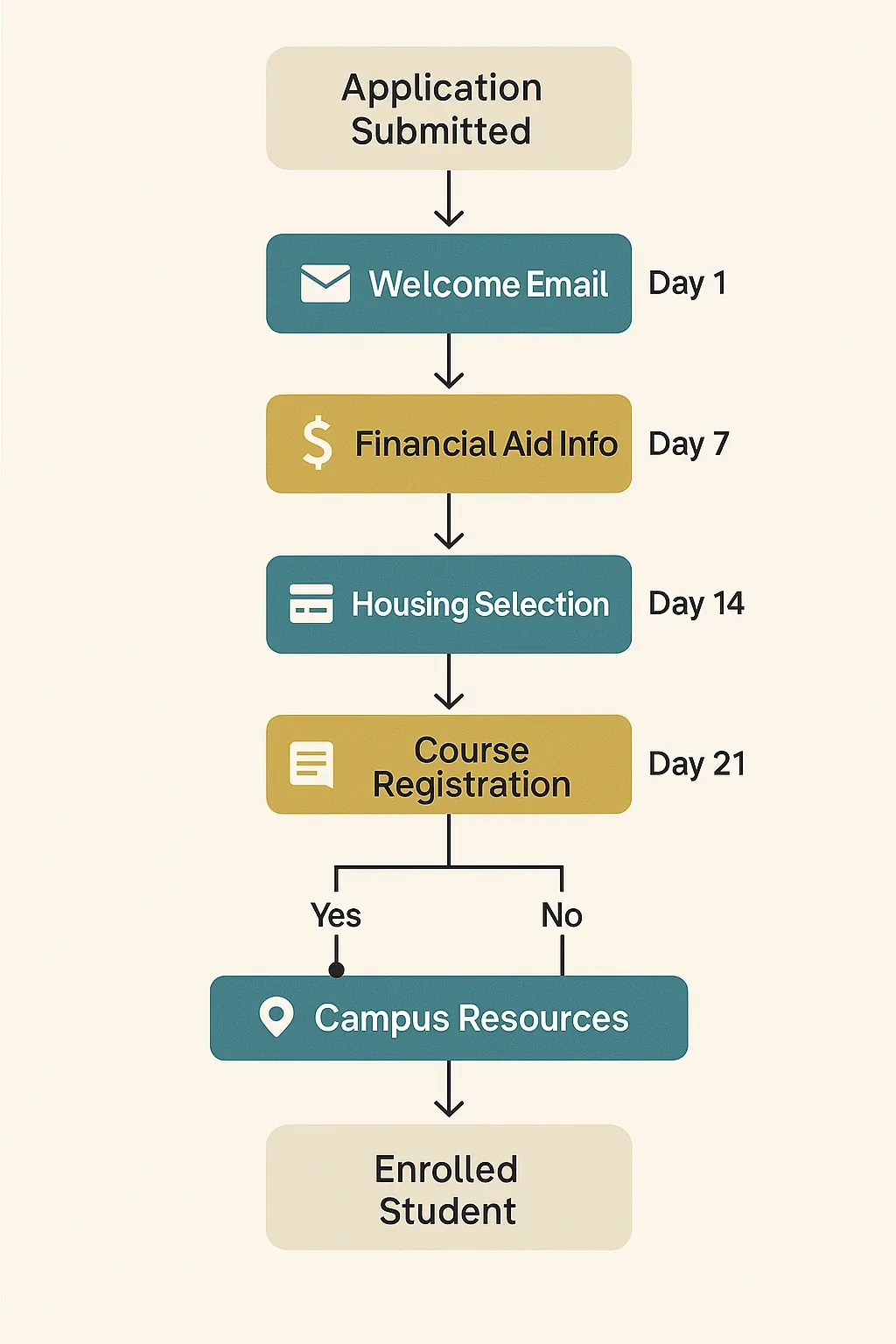
Educational institutions have predictable annual cycles and student lifecycle moments that benefit from automation. Here are essential workflows:
Student Lifecycle Workflows:
- Enrollment Nurture Series: Prospective students who submit applications receive 5-7 emails over 6 weeks highlighting program strengths, financial aid options, campus life, and decision deadlines.
- New Student Onboarding: Accepted students trigger a welcome series covering housing selection, course registration, campus resources, and orientation details.
- Academic Milestone Celebrations: Automated congratulations emails for dean's list achievements, scholarship awards, or program completions maintain positive touchpoints.
- Retention Check-ins: Students who haven't logged into the campus portal in 2+ weeks receive automated resource reminders and support service information.
Alumni Engagement Workflows:
- Graduation Transition: Recent graduates receive job search resources, alumni network invitations, and giving program introductions over their first year as alumni.
- Reunion Anniversary Triggers: Alumni automatically receive reunion invitations when approaching 5-year graduation intervals.
- Lapsed Donor Re-engagement: Former donors who haven't given in 18+ months trigger a 3-email series sharing impact stories and flexible giving options.
According to Technology for Higher Education Research Brief, institutions implementing automation workflows see 37% improvement in student engagement metrics and 28% reduction in administrative communication workload.
While full automation workflows are on many platforms' roadmaps (including ours at Groupmail), you can start implementing these strategies manually using scheduled email campaigns and organized contact groups.
Personalization Beyond First Names
Quick Answer: Effective personalization for education emails incorporates individual data points including program/major, campus location, involvement history, and milestone dates. This approach increases engagement by 47% compared to first-name-only personalization, creating messages that feel genuinely relevant to each recipient's educational journey.
Standard email personalization stops at "Dear [FirstName]," but educational institutions have rich data to make messages truly relevant. Salesforce Education Cloud Research shows that emails referencing specific program or campus details achieve 47% higher click-through rates than generic personalized emails.
Student Personalization Opportunities:
- Reference their specific major/program in subject lines and content
- Include campus location for multi-campus institutions
- Mention their involvement (athletics, clubs, student government)
- Acknowledge academic achievements (GPA milestones, honors)
- Link to major-specific resources and career services
Example: Instead of "Sarah, check out this career event," use "Sarah, finance employers are coming to campus—here's who's hiring finance majors."
Alumni Personalization Opportunities:
- Reference graduation year to create cohort identity
- Mention geographic region for local event invitations
- Acknowledge giving history and impact of past contributions
- Include personalized reunion countdown timers
- Reference specific memories from their enrollment years
Example: "Class of 2015: Remember when campus wifi barely worked? Here's how alumni giving transformed our technology infrastructure."
Use Groupmail's free AI Subject Line Tester to optimize personalized subject lines before sending, ensuring your customization improves rather than hurts performance.
🔧 "Emails referencing specific program or campus details achieve 47% higher click-through rates than generic personalized emails." — Salesforce Education Cloud
Dynamic content blocks allow one email template to display different images, stories, or calls-to-action based on recipient data. An alumni giving campaign might show different project funding needs to engineering grads versus liberal arts grads, aligning appeals with likely interests.
Timing and Frequency Optimization
Quick Answer: Students check email most actively between 10 AM-2 PM on weekdays, while alumni engagement peaks Tuesday-Thursday evenings between 7-9 PM. Send students no more than 2-3 emails per week; limit alumni communications to 1-2 emails weekly to maintain engagement without inbox fatigue.
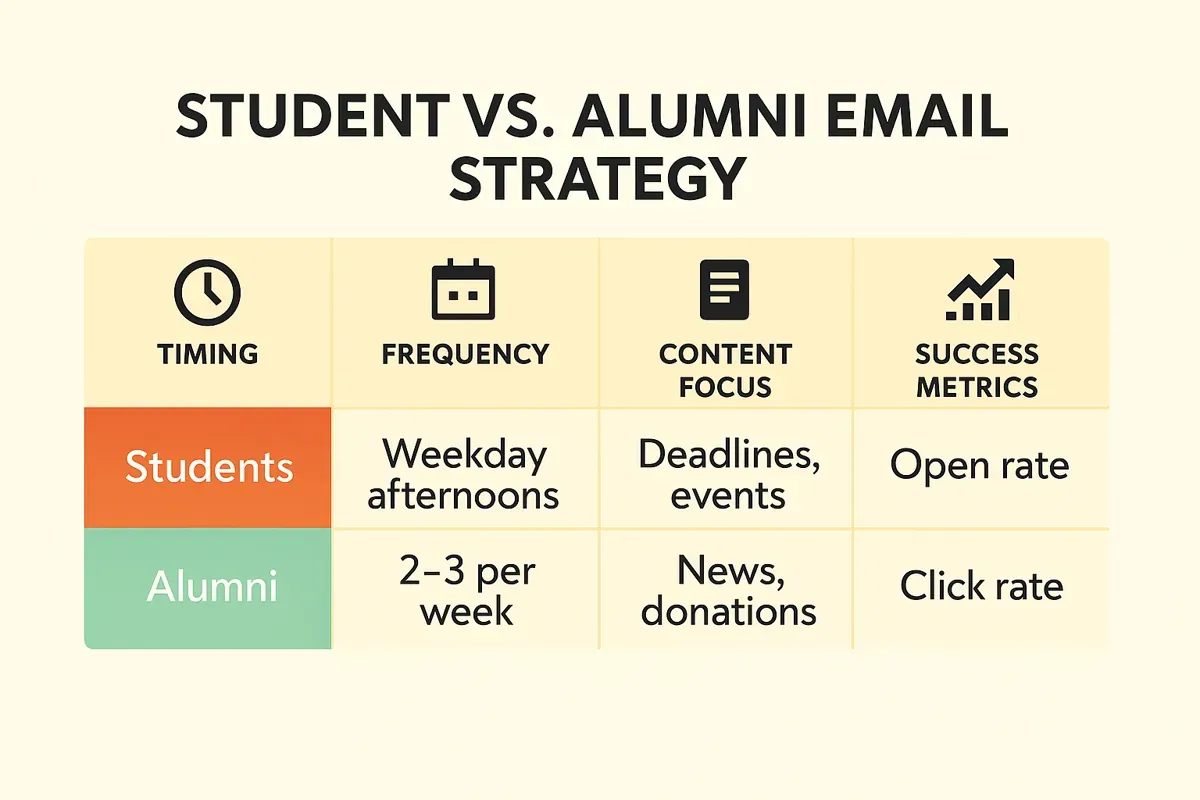
Send timing significantly impacts email performance. According to GetResponse Higher Education Email Marketing Study, Tuesday and Wednesday send times achieve 18-23% higher open rates than Monday or Friday for educational institutions.
Student Timing Patterns:
Students check email between classes, during study breaks, and while managing academic tasks. Peak engagement windows are:
- Tuesday-Thursday, 10 AM - 2 PM (between morning and afternoon classes)
- Sunday evenings, 6-9 PM (planning for the week ahead)
Avoid Friday afternoons and weekends when students disconnect from academic obligations. Never send critical deadline reminders on Friday—students may not see them until Monday.
Alumni Timing Patterns:
Alumni engage with institutional emails during personal time, not work hours. Optimal windows include:
- Tuesday-Thursday, 7-9 PM (after dinner, before evening commitments)
- Saturday mornings, 9-11 AM (weekend leisure browsing)
Frequency Guidelines:
Overcommunication damages engagement more than undercommunication. The National Research Center for College & University Admissions Email Frequency Study found that email fatigue occurs when institutions exceed:
- Students: 3 emails per week
- Alumni: 2 emails per week
Maintain value by making every email substantive. If you can't identify clear value for recipients, don't send it.
Test your timing using A/B splits, sending half your list at your current time and half at an alternative window. Track which performs better over 4-6 campaigns before committing to changes.
Measuring Success and Optimizing Performance
Quick Answer: Track open rates, click-through rates, conversion rates for specific goals, unsubscribe rates, and engagement trends over time. Educational email benchmarks target 25-30% open rates and 3-4% click-through rates, with donor conversion rates of 0.5-1.5% for alumni giving campaigns.
Email analytics reveal what's working and what needs adjustment. Focus on metrics tied to institutional goals rather than vanity metrics.
Essential Metrics:
- Open Rate: Percentage of recipients who open your email. Educational institutions average 25.8% (Campaign Monitor benchmarks). Below 20% indicates subject line or sender reputation issues.
- Click-Through Rate (CTR): Percentage of recipients who click links in your email. Target 3-4% for educational institutions. Low CTR suggests content relevance or call-to-action problems.
- Conversion Rate: Percentage of recipients who complete your desired action (RSVP, donate, register). Varies by campaign type but donor conversion rates typically fall between 0.5-1.5%.
- Unsubscribe Rate: Should stay below 0.5% per campaign. Higher rates indicate frequency, relevance, or content quality issues.
- Engagement Trend: Track whether individual recipients are increasingly or decreasingly engaged over time. This predicts future giving and involvement behavior.
Deliverability Monitoring:
Use Groupmail's free AI Spam Checker to test emails before sending, ensuring they pass spam filters and reach primary inboxes. Poor deliverability undermines all other optimization efforts.
A/B Testing Priorities:
Test one variable per campaign:
- Subject line variations (with/without personalization, question vs. statement)
- Send time comparisons (morning vs. evening)
- Call-to-action placement (top vs. bottom, button vs. text link)
- Content length (concise vs. detailed)
Run tests with sufficient sample sizes—at least 1,000 recipients per variation for statistically meaningful results.
Groupmail Features for Educational Institutions
Full Disclosure: We run Groupmail, an AI-powered email marketing platform. When we mention Groupmail features in this guide, it's because they directly address the strategies we're discussing. We're sharing what we've built to solve these exact problems.
Educational institutions need email platforms that handle scheduling, organization, and personalization without requiring technical expertise. Groupmail's features address specific challenges educators face:
Unlimited Sending on Paid Plans: Unlike platforms charging per-email, Groupmail's pricing bases costs on contact count with unlimited sends. This supports frequent student communications and multi-touch alumni engagement without budget concerns. The Starter Plan ($25/month) covers up to 5,000 contacts with unlimited emails.
AI-Powered Subject Line Optimization: The AI Subject Line Generator helps you craft compelling subject lines for different audience segments, while the AI Subject Line Tester scores your subject lines before sending, predicting open rate performance.
Drag-and-Drop Editor: Create professional emails without design skills. Choose from educational templates for newsletters, event invitations, and donation appeals, then customize with your branding and content.
Contact Group Organization: Organize your contacts into separate groups for different audiences—current students, alumni by graduation year, donors, event attendees. Send targeted campaigns to specific groups while maintaining one master contact list.
The Growth Plan ($45/month) adds the full AI toolkit, supporting institutions scaling their email operations to 25,000 contacts. Educational institutions typically see time savings from scheduled campaigns and organized contact groups while improving engagement metrics across all audience segments.
Access all Groupmail's free AI email marketing tools including spam checking, subject line testing, and generation without creating an account.
Best Practices Summary
Successful email marketing for education requires treating students and alumni as distinct audiences with different needs, timing preferences, and engagement motivations. Key principles include:
Segment ruthlessly: Generic mass emails underperform targeted messages by 40-50%. Invest time in audience segmentation based on status, program, location, and engagement history.
Plan strategically: Map out your email calendar for predictable lifecycle moments—enrollment, orientation, graduation, alumni anniversaries. Schedule campaigns in advance to maintain consistent communication without last-minute scrambling.
Personalize meaningfully: Go beyond first names to reference specific programs, involvement, and achievements. Show recipients you understand their unique connection to your institution.
Optimize timing: Send students practical information during weekday study breaks. Reach alumni during evening leisure time when they're open to emotional institutional connections.
Measure continuously: Track performance against benchmarks, test variations systematically, and refine based on data rather than assumptions.
Explore the AI Email Marketing Tools Directory for additional resources supporting your email strategy, including tools for design, analytics, and optimization.
Key Terms
Open Rate: Percentage of email recipients who open your email, calculated by dividing unique opens by delivered emails. Educational institutions average 25-30%.
Click-Through Rate (CTR): Percentage of recipients who click at least one link in your email, indicating content relevance and call-to-action effectiveness.
Segmentation: Dividing your email list into subgroups based on shared characteristics like student status, graduation year, program, or engagement level.
Automation Workflow: Pre-built email series triggered by specific actions or dates, such as application submission, enrollment, or graduation anniversaries.
Personalization: Customizing email content for individual recipients using data like name, major, campus, or involvement history beyond generic mass messages.
A/B Testing: Sending two email variations to segments of your list to determine which performs better, then sending the winner to remaining recipients.
Engagement Score: Metric tracking individual recipient's interaction history with your emails—opens, clicks, and conversions—over time to predict future behavior.
Conversion Rate: Percentage of email recipients who complete your desired action, such as registering for an event, making a donation, or submitting an application.
Deliverability: The rate at which your emails successfully reach recipients' primary inboxes rather than spam folders or getting blocked entirely.
Unsubscribe Rate: Percentage of recipients who opt out of your email list per campaign, indicating satisfaction with frequency and content relevance.
Frequently Asked Questions
What's the ideal email frequency for student communications?
Send students 2-3 emails per week maximum, focusing on actionable information tied to immediate needs like deadlines, events, or resources. More frequent sending leads to inbox fatigue and declining open rates. Reserve daily emails for critical situations only, such as campus emergencies or urgent deadline reminders. Survey your students annually about communication preferences to adjust frequency based on feedback.
How do I re-engage inactive alumni who haven't opened emails in years?
Create a targeted re-engagement campaign for alumni who haven't opened emails in 12+ months. Send a 3-email series over 6 weeks: first, ask if they still want to hear from you with easy preference update links; second, share a compelling campus transformation story showing tangible change; third, offer an easy low-commitment engagement opportunity like a 5-minute alumni survey. Remove permanently unengaged subscribers after this series to improve overall deliverability and sender reputation.
Should I send different emails to donors versus non-donors?
Yes. Donors deserve recognition and stewardship content showing their impact, while non-donors need inspiration and entry points for first-time giving. Segment alumni by giving history and create parallel content calendars: donors receive impact reports and exclusive updates, while prospects receive problem-focused stories demonstrating how donations solve real challenges. Both groups need regular non-fundraising touchpoints to avoid feeling like ATMs.
What subject lines work best for educational emails?
Students respond to specific, action-oriented subject lines like "Financial aid deadline: March 15" or "Career fair tomorrow: Here's who's coming." Alumni engage with curiosity-driven subject lines like "See how the campus has changed since you graduated" or "Your fellow Class of 2010 grads are doing this." Test subject lines using AI tools before sending to predict open rate performance. Avoid ALL CAPS, excessive punctuation, or spam trigger words that hurt deliverability.
How can I improve email deliverability to Gmail and Outlook?
Focus on engagement quality over list size—consistently low open rates signal to providers that recipients don't value your emails. Remove chronically inactive subscribers every 6-12 months. Authenticate your sending domain with SPF, DKIM, and DMARC records to prove legitimacy. Avoid spam trigger words like "free," "urgent," or "act now" in subject lines. Test emails with spam checking tools before sending to identify and fix deliverability issues. Warm up new sending domains gradually, starting with small volumes to engaged subscribers before scaling.
What metrics matter most for measuring email success?
For student communications, prioritize click-through rates on action links (registration, resources, RSVP) since utility drives value. For alumni engagement, track both open rates (indicating interest) and conversion rates on specific goals like event registrations or donations. Monitor unsubscribe rates below 0.5% per campaign. Most importantly, track engagement trends over time—are individual recipients becoming more or less engaged? This predicts long-term relationship health better than single-campaign metrics.
Conclusion
Email marketing for education succeeds when you treat it as relationship-building rather than broadcasting. Students need timely, actionable information delivered when they're most receptive. Alumni want emotional connection to their alma mater and meaningful opportunities to contribute. Neither group responds to generic mass communications.
Start by segmenting your lists beyond basic categories—dig into program details, involvement history, and engagement patterns. Plan scheduled email campaigns for predictable moments in the student and alumni lifecycle, freeing your team for strategic relationship work. Personalize messages with specific details that show you understand each recipient's unique connection to your institution.
Ready to implement these strategies with tools built specifically for educational engagement? Start with Groupmail's free account—no credit card required. Get unlimited sends on paid plans, AI-powered subject line optimization, and organized contact groups today.


